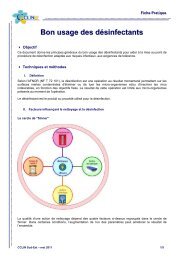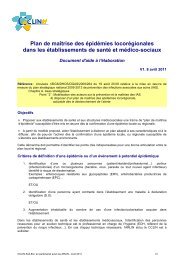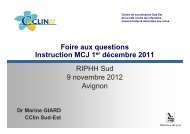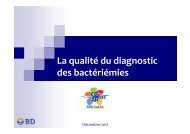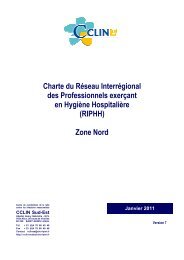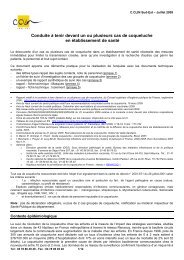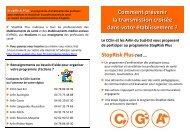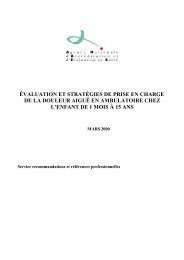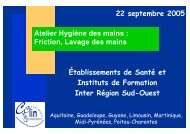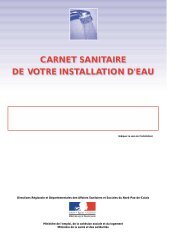Pédiculoses et gale - Lyon mai 2011 [Mode de ... - CClin Sud-Est
Pédiculoses et gale - Lyon mai 2011 [Mode de ... - CClin Sud-Est
Pédiculoses et gale - Lyon mai 2011 [Mode de ... - CClin Sud-Est
Create successful ePaper yourself
Turn your PDF publications into a flip-book with our unique Google optimized e-Paper software.
PEDICULOSES ET GALE<br />
Arezki IZRI<br />
PARASITOLOGIE<br />
CHU AVICENNE, UNIVERSITE PARIS 13<br />
93009 BOBIGNY
PEDICULOSES<br />
Ectoparasitoses/p<strong>et</strong>its insectes hématophages<br />
3 espèces spécifiques à l’Homme<br />
Pediculus humanus capitis<br />
Pediculus h. corporis (P. h. humanus)<br />
Morphologie semblable<br />
Epidémiologie différente<br />
Gènes distincts? 1,2<br />
Phthirius pubis = pou du pubis = morpion<br />
3 affections d’actualité <strong>de</strong>puis l’antiquité<br />
1-Leo NP, <strong>et</strong> al. Heredity, 2005<br />
2-Li <strong>et</strong> al, PNTD, 2010
Phthirius pubis (1)<br />
Phthiriose = IST bénigne, rare<br />
Parasite sur poils du pubis<br />
parfois barbe, cils, frange frontale (enfants)<br />
<strong>mai</strong>s aussi toute la pilosité, y compris le CC
Traitement :<br />
Rasage<br />
Phthirus pubis (3)<br />
Insectici<strong>de</strong>s (Spraypax®)<br />
Ivermectine (>12kg) ?<br />
200µg/kg à J1 <strong>et</strong> J10<br />
... suj<strong>et</strong>s contacts !!
Pediculus h. corporis (1)<br />
Seul pou reconnu vecteur <strong>de</strong> maladies :<br />
typhus exanthématique<br />
(R. prowazekii)<br />
fièvre <strong>de</strong>s tranchées<br />
(R. quintana)<br />
fièvre récurrente à poux<br />
(B. recurrentis)<br />
Autres pathogènes?
Pediculus h. corporis (2)<br />
Vit accroché aux vêtements, se nourrit sur la peau tout en restant<br />
accroché au vêtements
Pediculus h. corporis (3)<br />
Traitement : poux dans face interne <strong>de</strong>s<br />
vêtements => Lavage tissus > 50°C 1<br />
Ivermectine 2 ?<br />
1-Izri A, Chosidow O.<br />
CID, 2005<br />
2-Foucault C. JID, 2006 Pediculus h. corporis pond ses œufs sur<br />
les vêtements.<br />
Les lentes sont collées aux fibres textiles.
Pediculus h. capitis (1)<br />
Pou <strong>de</strong> tête = problème <strong>de</strong> santé publique<br />
>300 millions <strong>de</strong> suj<strong>et</strong>s infestés<br />
Toutes les couches <strong>de</strong> la société<br />
0 à >60 % d’enfants parasités selon le pays, le<br />
sexe, l’âge,…<br />
Les pédiculoses comptent parmi les infections<br />
les plus fréquentes chez les enfants après les<br />
infections ORL<br />
Bénignes?<br />
Falagas ME, Emerg Infect Dis,2008<br />
Heukelbach <strong>et</strong> al, Br J Dermatol,2005<br />
Bachman <strong>et</strong> al. J Sch Nurs,2000<br />
Li <strong>et</strong> al. PLoS Negl Trop Dis. 2010<br />
Schroff S. Ann Emerg Med,2010<br />
Bonilla <strong>et</strong> al. Emerg Infect Dis. 2009<br />
Houhamdi <strong>et</strong> al. Med Trop (Mars),2005<br />
Fournier <strong>et</strong> al. Emerg Infect Dis,2002<br />
Gratz NG. WHO, 1997
Pediculus h. capitis (2)<br />
P<strong>et</strong>it insecte, 2-3mm,<br />
Ectoparasite du cuir chevelu,<br />
Contagieux, fréquent, cosmopolite,<br />
Plus fréquent dans les communautés<br />
Souvent associé à la pauvr<strong>et</strong>é …<br />
Résistant aux insectici<strong>de</strong>s<br />
Toloza <strong>et</strong> al. Parasitol Res. 2009.<br />
Al-Maktari MT. J Egypt Soc Parasitol. 2008<br />
Catala <strong>et</strong> al. Rev Sau<strong>de</strong> Publica. 2005<br />
Counahan ML <strong>et</strong> al. J Paediatr Child Health. 2004<br />
Perotti <strong>et</strong> al. BMC Gen<strong>et</strong>. 2004<br />
Buczek <strong>et</strong> al. Eur J Epi<strong>de</strong>miol. 2004
Orifices respiratoires<br />
Trompe rétractile<br />
pinces<br />
LE PARASITE : BIOLOGIE
5 à 10 œufs/jour pendant 1 mois
Éclosion : 8 jours<br />
La coque vi<strong>de</strong>, blanchâtre, reste<br />
fixée au cheveu # pellicule<br />
Comme l’adulte, la larve est<br />
hématophage <strong>et</strong> se nourrit 2 à 4 f/j
Le pou adulte<br />
mesure 2 à 3 mm <strong>de</strong><br />
long.<br />
La femelle est<br />
plus gran<strong>de</strong> que le<br />
mâle<br />
La larve subit 4 mues<br />
avant <strong>de</strong>venir un<br />
adulte mâle ou femelle<br />
en 12 à 15 jours
TRANSMISSION = directe <strong>de</strong> tête à<br />
tête, poux adultes d’un suj<strong>et</strong> à l’autre*<br />
* Takano-Lee M, <strong>et</strong> al. Int J Dermatol. 2005
EPIDEMIOLOGIE (2)<br />
Argentine 1 : 61,4% <strong>de</strong>s écoliers <strong>de</strong> La Rioja<br />
Australie 2 : 13% <strong>de</strong>s élèves (0 à 28%), 2F/1M<br />
Arabie saoudite 3 : 5,2% <strong>de</strong>s filles<br />
Brésil 4 : 28,1% - 43,4% pauvres. 10-14 ans<br />
Belgique 5 : 8,9% <strong>de</strong>s écoliers <strong>de</strong> 2,5 à 12 ans<br />
Espagne (Bilbao: 9,39%) 6<br />
Paris 7 : 5 à 10% <strong>de</strong>s écoliers <strong>de</strong> 5 à 14 ans<br />
1-Catala S <strong>et</strong> al. Rev Sau<strong>de</strong> Publica. 2005<br />
2-Counahan ML <strong>et</strong> al. J Paediatr Child Health. 2004<br />
3-Al-Saeed WY <strong>et</strong> al. Saudi Med J. 2006<br />
4-Heukelbach J <strong>et</strong> al. Br J Dermatol. 2005<br />
5-Willems S. <strong>et</strong> al. Eur J Dermatol. 2005<br />
6-Magra Saenz <strong>de</strong> Buruaga <strong>et</strong> al. Rev Sanid Hig Publica. 1989<br />
7-Chosidow O, <strong>et</strong> al. Lanc<strong>et</strong>. 1994
Prurit<br />
Lésions <strong>de</strong><br />
grattage<br />
Troubles du<br />
sommeil?<br />
Agitation?<br />
R<strong>et</strong>ard scolaire?<br />
CLINIQUE
DIAGNOSTIC<br />
Mise en évi<strong>de</strong>nce <strong>de</strong>s lentes<br />
Les lentes vi<strong>de</strong>s s’observent plus facilement<br />
que les poux adultes<br />
Blanchâtres,<br />
« Pellicules » qui<br />
restent accrochées<br />
aux cheveux<br />
Mise en évi<strong>de</strong>nce<br />
<strong>de</strong>s poux<br />
Peigne fin
ORGANOCHLORÉS<br />
DDT, HCH<br />
Toxiques<br />
Rémanents<br />
TRAITEMENT (1)<br />
Résistance <strong>de</strong>puis 1952 1<br />
Ne sont plus utilisés en France 2<br />
1-Hurlbut HS <strong>et</strong> al. Science. 1952<br />
2-Vidal 2009
TRAITEMENT (2)<br />
ORGANOPHOSPHORES: Malathion<br />
Prio<strong>de</strong>rm® <strong>et</strong> Paraplus®<br />
Encore efficace en France 1<br />
Résistance signalée 2<br />
Acci<strong>de</strong>nts 3<br />
Bronchospasme, intoxication aiguë, irritation du<br />
cuir chevelu, alopécies,…<br />
1-Chosidow <strong>et</strong> al. Lanc<strong>et</strong>. 1994<br />
2-Izri A <strong>et</strong> Brière C. Presse Med. 1995<br />
3-Burkhat CG, Burkhat CN. Expert Opin Drug Saf. 2006
TRAITEMENT (3)<br />
PYRETHRE ET PYRETHRINES<br />
Peu toxiques, bien tolérés<br />
Encore efficaces dans certaines régions 1<br />
Résistance démontrée 2,3,4,5<br />
échecs thérapeutiques, tests ex-vivo <strong>et</strong> mise<br />
en évi<strong>de</strong>nce <strong>de</strong> mutations génétiques<br />
Leucémies? 6<br />
1-Tomita T, <strong>et</strong> al. J Med Entomol. 2003<br />
2-Gonzales Audino P, <strong>et</strong> al. J Med Entomol. 2005<br />
3-Chosidow O, <strong>et</strong> al. Lanc<strong>et</strong>. 1994<br />
4-Yoon KS, <strong>et</strong> al. Arch Dermatol. 2003<br />
5-Durand <strong>et</strong> al. J Med Entomol, 2007<br />
6-Menegaux F, <strong>et</strong> al. Occup Environ. 2006
RESISTANCE DES POUX A PARIS<br />
• Janvier 2008 – Juin 2009<br />
• 74 écoles, 682 classes, 14.447 élèves inclus<br />
• 1.264 cas suspects, 574 parasités<br />
• Prévalence <strong>de</strong> Pediculus h. capitis: 2,2%<br />
• 7.400 poux prélevés<br />
• PCR : gène Kdr (T929I <strong>et</strong> L932F)<br />
846 ADN extraits<br />
846 PCR-Kdr réalisées <strong>et</strong> séquencées<br />
670 séquences formatives :<br />
661 (98,7%) homozygotes résistants (RR)<br />
09 (1.3%) homozygotes sensibles (SS)
IVERMECTINE 1,2<br />
TRAITEMENT (4)<br />
Semi-synth<strong>et</strong>ic macrolytic lactone<br />
comprimés à 3 mg<br />
200µg/kg à J1 <strong>et</strong> J10<br />
>12 Kg<br />
Efficacité > malathion<br />
Traitement réservé aux pédiculoses difficiles<br />
à traiter<br />
Précautions:femme enceinte, suj<strong>et</strong> centreafricain,...<br />
eff<strong>et</strong>s indésirables<br />
1-Chosidow <strong>et</strong> al. NEJM, 2010<br />
2-Pilger <strong>et</strong> al. Bull World Health Organ, 2010
TRAITEMENT (5) : LES HUILES<br />
<strong>Mo<strong>de</strong></strong> d’action ?<br />
Obstruction <strong>de</strong>s stigmates respiratoires ?<br />
Diméticone 4%, 1h à 8h :<br />
=> 60 à 70% <strong>de</strong> suj<strong>et</strong>s guéris 1,2<br />
Huile <strong>de</strong> coco<br />
Huile d’anis<br />
Lavan<strong>de</strong><br />
...<br />
1-Burgess <strong>et</strong> al. BMJ. 2005<br />
2-Izri <strong>et</strong> al. Parasite, 2010
AUTRES « TRAITEMENTS » (6)<br />
gels,<br />
Chaleur sèche,<br />
“Fers” chauds,<br />
Casques tueurs <strong>de</strong> poux,<br />
…<br />
Efficicacité? Pas toujours prouvée …<br />
Peigne fin<br />
Pearlman D. Pediatrics,2004 & 2005<br />
Takano-Lee <strong>et</strong> al. J Pediatr Nurs,2004<br />
Goates <strong>et</strong> al. Pediatrics. 2006<br />
Kersten H. J Pediatr. 2007<br />
Heukelbach <strong>et</strong> al. Med V<strong>et</strong> Entomol,2008<br />
Asenov <strong>et</strong> al. Int J Dermatol,2009<br />
Ab<strong>de</strong>l-Ghaffar <strong>et</strong> al. Parasitol Res. 2010<br />
Choi <strong>et</strong> al. J Med Entomol. 2010<br />
Kamaraj <strong>et</strong> al. Parasitol Res. 2010
LA GALE<br />
Sarcoptes scabiei<br />
acarien, ectoparasite, 300 à 500µm
corps recouvert « d’épines »
La femelle creuse <strong>de</strong>s sillons dans l ’épi<strong>de</strong>rme où elle se<br />
nourrit <strong>et</strong> pond 5 à 10 œufs/jour
LA GALE : CLINIQUE<br />
Suj<strong>et</strong> immunocompétent : adulte <strong>et</strong> enfant<br />
Prurit<br />
Lésions maculo-papuleuses<br />
Sillons<br />
Siège : plis, EID, poign<strong>et</strong>s, …<br />
Organes génitaux, seins (MST)<br />
Epargne visage, dos, paume <strong>de</strong>s <strong>mai</strong>ns,<br />
plante <strong>de</strong>s pieds<br />
Lésions <strong>de</strong> grattage, parfois surinfectées
Gale du nourrisson : plante <strong>de</strong>s pieds <strong>et</strong> paume <strong>de</strong>s<br />
<strong>mai</strong>ns touchées. Lésions souvent surinfectées
Gale <strong>de</strong>s personnes âgées <strong>et</strong> <strong>de</strong>s suj<strong>et</strong>s immunodéprimés:<br />
forme diffuse
Gale <strong>de</strong>s personnes âgées <strong>et</strong> <strong>de</strong>s suj<strong>et</strong>s<br />
immunodéprimés: forme croûteuse
Gale <strong>de</strong>s personnes âgées <strong>et</strong> <strong>de</strong>s suj<strong>et</strong>s immunodéprimés:<br />
forme croûteuse
CLINIQUE<br />
GALE : DIAGNOSTIC<br />
NOTION DE CONTAGE<br />
DIAGNOSTIC PARASITOLOGIQUE :<br />
Prélèvement<br />
Mise en évi<strong>de</strong>nce du parasite
GALE : DIAGNOSTIC DIFFERENTIEL<br />
ECZEMA<br />
PSORIASIS<br />
MYCOSES<br />
AUTRES DERMATOSES
LA GALE : TRAITEMENT (1)<br />
Benzoate <strong>de</strong> benzyl : Ascabiol ®<br />
Perméthrine : Sprégal ®<br />
Ivermectine : Stromectol ®<br />
Résistance? Chez l’Homme? 1,2 Chez l’animal? 3<br />
Echecs thérapeutiques?<br />
Problème d’immunité (Th2/Th1) 4<br />
1-Van Den Hoek <strong>et</strong> al. Eurosurveillance 2008<br />
2-Darwin C. Future Microbiol, 2008<br />
3-Terada <strong>et</strong> al. V<strong>et</strong> Dermatol, 2010<br />
4-Walton SF. Parasite Immunol, 2010
LA GALE : TRAITEMENT (2)<br />
Mesures complémentaires<br />
Enquête<br />
Traitement <strong>de</strong>s suj<strong>et</strong>s contacts<br />
Désinfection <strong>de</strong> l’environnement<br />
Apar*<br />
Acardust*
LA GALE : PREVENTION<br />
Enquête <strong>et</strong> prise en charge <strong>de</strong>s suj<strong>et</strong>s<br />
contacts+++<br />
Décontamination <strong>de</strong> l’environnement <strong>de</strong>s<br />
suj<strong>et</strong>s infectés<br />
Suivi après traitement<br />
Concernant les hôpitaux, <strong>mai</strong>sons <strong>de</strong><br />
r<strong>et</strong>raites <strong>et</strong> autres collectivités, surtout<br />
services <strong>de</strong>s personnes âgées:<br />
➢ Examen systématique à l’entrée<br />
➢ Examen périodique <strong>de</strong>s suj<strong>et</strong>s<br />
hospitalisés



